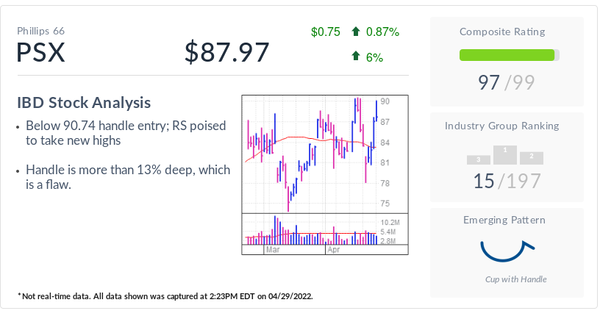Matson, an ocean-shipping company focused on the Pacific, reported first-quarter earnings on Tuesday that beat expectations, boosted by demand for its China shipping services and an ongoing supply-chain mess that it said seemed likely to endure in the months ahead.
The Honolulu-based company reiterated its expectations for the current supply-demand backdrop to persist through at least the peak October shipping season. And it echoed remarks made when it reported preliminary results last month, noting supply-chain issues in China and the U.S.' West Coast.
Matson stock rose 2.5% overnight on Tuesday. Other shipping stocks were quiet.
Covid restrictions in China, Russia's war in Ukraine and still-robust shipping demand continue to grate on that distribution network and keep transportation costs elevated. Dockworkers at the ports of Los Angeles and Long Beach are still trying to clear shoreside container-ship traffic jams.
Matson Earnings, Matson Stock
Matson earned $8.23 per share, at the high end of its own expectations and above FactSet estimates for $7.03. Revenue came in at $1.166 billion, above forecasts for $1.114 billion.
Matson, when it released preliminary results last month, said it expected first-quarter earnings per share of $8-$8.25, helped by demand for its expedited services to and from China and the West Coast.
"Within Ocean Transportation, our China service continued to see significant demand for its expedited ocean services as volume for e-commerce, garments and other goods remained elevated," CEO Matt Cox said in a statement on Tuesday. The remarks mirrored those in Matson's preliminary results.
During regular trading hours, Matson stock rose 3.5% to 91.47 in the stock market today. Shares rebounded from their 200-day line. MATX stock is still well below its 50-day line after tumbling from highs in late March.
Shares have a strong 96 Composite Rating. Matson's EPS Rating, a gauge of company profit growth, is a best-possible 99.
Among other shipping stocks, ZIM Integrated Shipping dipped 0.3% after hours, after leaping 8.5% earlier, back above its 50-day line.
Danaos was unchanged after hours. During the regular session, it climbed 3.1%, rebounding from its 200-day. Star Bulk Carriers, which is a dry bulk shipper, was also unchanged. During the day, that stock added 4.5%, bouncing from its 50-day line and not far from highs.
Founded in 1882, Matson runs cargo ships between the West Coast, including Alaska, and Hawaii, Guam, Japan, China and other nations. Those ships, which the company owns or charters, carry everything from household goods, automobiles, apparel and electronics. Matson also runs a logistics business.
Hawaii, China Demand
Matson stock has benefited from a rebound in demand for goods in Hawaii, one of its main shipping lanes, as tourism resumes in the state. However, analysts at Stephens said ongoing Covid lockdowns in parts of China could weigh on freight volumes in the near term.
Shipping stocks have moved higher for much of the past two years, after Covid-related disruptions sent shipping costs higher for businesses importing products and customers paying for them. The possibility of a strike among the West Coast's union port workers, whose contract expires in July, and Russia's war in Ukraine could further strain the world's shipping network.
The pandemic's shutdown of the global economy in 2020 gummed up the flow of containers needed to ship goods, while a surge of online buying in the U.S. ran up against port and factory restrictions in Asia and backed-up shipyards and warehouses, squeezing shipping costs higher last year. More businesses, as a result, are trying to pad their inventories to insulate themselves against those disruptions, keeping demand elevated.
Matson over the past two years has expanded its expedited services from China to the West Coast due to heightened demand.
'Supply Chain Challenges'
Matson last month noted "supply chain challenges in China, primarily due to actions to mitigate the spread of Covid-19, as well as continued supply chain constraints and congestion on the U.S. West Coast, elevated consumption trends, and inventory restocking."
It also said it expected little to change in the supply and demand backdrop.
"Despite the near-term uncertainty presented by the supply chain challenges in China," the company continued, "we expect a combination of the current supply and demand factors to remain largely in place through at least the October peak season and continue to expect elevated demand for our China service for most of this year."










